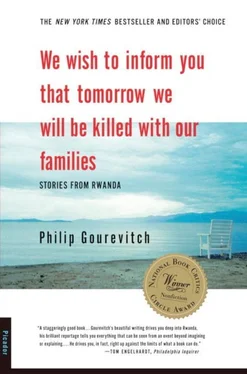The next day, the first French troops of Opération Turquoise rolled from Goma into northwestern Rwanda, where they were welcomed by enthralled bands of interahamwe —singing, waving French tricolor flags, and carrying signs with slogans like “Welcome French Hutus”—while a disc jockey at RTLM advised Hutu women to gussy themselves up for the white men, taunting, “Now that the Tutsi girls are all dead, it’s your chance.”
The timing of Opération Turquoise was striking. By late May, the massacre of Tutsis had slowed down because most of them had already been massacred. The hunt continued, of course, especially in the western provinces of Kibuye and Cyangugu, but Gérard Prunier, a political scientist who was part of the task force that worked out France’s intervention scheme, has written that the great worry in Paris as plans for the mobilization got underway in mid-June was whether its troops would find any large concentrations of Tutsis to rescue before the television cameras. In much of Rwanda, Hutu Power’s message to the masses had been changed from an order to kill to an order to flee before the RPF advance. On April 28—long ago, in the compressed time frame of the Rwandan apocalypse—a quarter of a million Hutus, bolting before the RPF advance, had streamed over a bridge into Tanzania from the eastern province of Kibungo. This was the largest and speediest mass flight across an international border in modern history, and although it included whole formations of interahamwe, military units, town councils, and the civilian throngs who had strewn the church at Nyarubuye and the rest of Kibungo with corpses, those who fled were indiscriminately received with open arms by UN and humanitarian agencies and accommodated as refugees in giant camps.
Before France even began talking of a “humanitarian” military expedition, the RPF controlled eastern Rwanda, and its forces were moving steadily westward in a broad pincer movement to the north and south of Kigali. As they progressed, the full extent of the extermination of Tutsis in the areas they conquered was broadcast to the world. While Rwandan government leaders and RTLM claimed that the RPF was killing every Hutu it found alive, and French military spokesmen promoted the idea of a “two-way genocide” and called the RPF the Khmer Noir, the dominant impression in the international press was of an astonishingly disciplined and correct rebel army, determined to restore order. And for Tutsis and most Hutus of good conscience the best hope for salvation was to reach, or be reached by, the RPF zone.
The RPF, which consisted at that time of about twenty thousand fighters, was forcing a national army more than twice its size, backed by militias and a great mass of civilians mobilized for “self-defense,” to retreat. For anybody concerned about the welfare of Hutu Power, as so many in France were, the obvious question would seem to have been: What went wrong? The simplest answer was that Rwanda’s Hutu Power regime was sapping its frontline military effort in favor of completing the genocide, just as the Germans had done in the final months of World War II. But a subtler dynamic was at work in Rwanda as well. From the start of the war with the RPF in 1990, Hutu extremists had promoted their genocidal aspirations with the world-upside-down rhetoric of Hutu victimization. Now Hutu Power had presided over one of the most outrageous crimes in a century of seemingly relentless mass political murder, and the only way to get away with it was to continue to play the victim. In yielding Rwanda to the RPF and leading vast flocks into exile, the Hutu Power leaders could retain control of their subjects, establish a rump “refugee” state in UN-sponsored camps, and pretend that their worst fears had been justified.
France promised the Security Council that its objective in Rwanda “naturally excludes any interference in the development of the balance of military forces between the parties involved in the conflict.” But within a week of their arrival, French troops occupied nearly a quarter of the country, sweeping across southwestern Rwanda to stand face to face with the RPF. At that point, France suddenly reinterpreted its “humanitarian” venture and declared its intention to turn the entire territory it had conquered into a “safe zone.” The RPF was not alone in asking: safe for whom? France’s own ex-President, Valéry Giscard d’Estaing, accused the French command of “protecting some of those who had carried out the massacres.”
The RPF didn’t waste much time in argument. It launched an all-out offensive to limit the Zone Turquoise . On July 2 it captured Butare, and on July 4 it took Kigali, scuttling Hutu Power’s earlier plans to mark that day with a funeral for President Habyarimana and a celebration of the total eradication of Tutsis from the capital.
OPÉRATION TURQUOISE WAS eventually credited with rescuing at least ten thousand Tutsis in western Rwanda, but thousands more continued to be killed in the French-occupied zone. Hutu Power brigades draped their vehicles with French flags to lure Tutsis from hiding to their deaths; and even when real French troops found survivors, they often told them to wait for transport, then went away and returned to find that those they had “saved” were corpses. From the moment they arrived, and wherever they went, the French forces supported and preserved the same local political leaders who had presided over the genocide. While the United States still had not managed to deliver the armored personnel carriers promised to UNAMIR’s African volunteers, the French had arrived in Zaire decked for battle, with an awesome array of artillery and armor, and a fleet of twenty military aircraft that was instantly the most imposing flying power in central Africa. And just as they embraced the Hutu Power military regime and its militias as the legitimate authorities of a state under rebel siege, they openly regarded the RPF as the enemy—at least until the fall of Butare. Then the French softened their tone. They didn’t exactly back down, but the sneering animosity with which Turquoise spokesmen referred to the rebels suddenly gave way to something like grudging respect, and rumors began to circulate that the RPF had scored a direct military victory against France. Several years later, I asked Major General Paul Kagame, who had led the RPF to victory, whether there was any truth to this theory.
“Something like that,” Kagame told me. “It occurred during our approach to Butare. I received from General Dallaire of UNAMIR a message from the French general in Goma telling me that we should not enter Butare. They were trying to tell me there would be a fight.” Kagame told Dallaire that he “could not tolerate such a provocation and such arrogance on the part of the French.” Then, he recalled, “I told the troops to change course, to move to Butare now. They arrived in the evening. I told them just to surround the town and stay put. I didn’t want them to get involved in a firefight at night. So they took positions and waited until morning. When our troops entered, they found that the French had secretly moved out to Gikongoro”—to the west. “But then, through Dallaire, they asked permission to return for some Catholic sisters and some orphans they wanted to take away. I cleared it. The French came back, but they didn’t know that we had already secured the route from Gikongoro to Butare. We had set a long ambush, nearly two companies along the road.”
The French convoy consisted of about twenty-five vehicles, and as it left Butare, Kagame’s forces sprang their trap and ordered the French to submit each vehicle to inspection. “Our interest was to make sure none of these people they were taking were FAR or militias. The French refused. Their jeeps were mounted with machine guns, so they turned them on our troops as a sign of hostility. When the soldiers in the ambush realized there was going to be a confrontation, they came out, and a few fellows who had rocket-propelled grenade launchers targeted the jeeps. When the French soldiers saw that, they were all instructed to point their guns upward. And they did. They allowed our soldiers to carry out the inspection.” In one of the last vehicles, Kagame said, two government soldiers were found. One ran away, and was shot dead, and Kagame added, “Maybe they killed the other one, too.” At the sound of shooting, the French vehicles that had been cleared to go ahead turned on the road and began firing from afar, but the exchange lasted less than a minute.
Читать дальше











